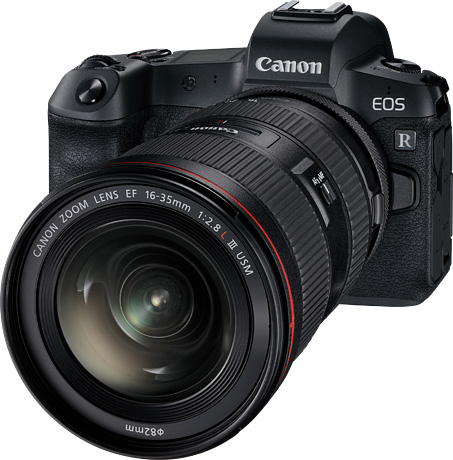 Japan
Japan Americas
Americas Europe, Asia, Oceania
Europe, Asia, Oceania
- Outline
| Marketed | October 2018 |
| Original Price | Open price |
| Specifications | Open PDF (119KB)  |
Through the combination of high-performance RF lenses1, a 35mm full-frame CMOS sensor with approximately 30.3 million effective pixels2 and the latest DIGIC 8 image processor, the EOS R makes possible highly expressive, high-image-quality shooting. Digital Lens Optimizer, which corrects for such factors as lens aberrations, effectively draws on the power of RF lenses to send correction data to the camera body, enabling corrections that don’t impact continuous shooting speed3. What’s more, achieving a standard ISO sensitivity range of 100–40000, when used in combination with a fast lens the EOS R makes possible high-image-quality shooting even in such low-light scenes as indoors and nighttime.
Through Dual Pixel CMOS AF (DPAF), an autofocus technology in which each effective pixel on the CMOS sensor is able to perform both phase-difference autofocusing and imaging functions, and the optimization of RF lens drive controls, the EOS R achieves focus speeds as short as approximately 0.05 seconds4. When used in combination with compatible lenses, the camera achieves an expanded focus area5 of approximately 100% (vertically) x 88%(horizontally). What’s more, users can choose fromas many as 5,655 selectable points6, enabling greater composition freedom when shooting. Additionally, the EOS R achieves an EOS-series-first low-light limit of EV-67, making possible highly precise focusing even in low-light scenarios where distinguishing subjects would be difficult for the human eye.
The EOS R features an approximately 3.69-million-dot built-in high-resolution electronic viewfinder (EVF) that allows users to confirm the effects of their applied shooting settings. Used in conjunction with the camera’s newly employed control methods, users can concentrate on shooting without having to look away from their subject.
1 Using one of four dedicated mount adapters, this camera makes possible the use of existing EF and EF-S lenses in addition to the newly developed RF lenses. Excluding EF-M lenses and CN-E EF Cinema lenses.
2 Actual pixel count: approximately 31.7million pixels
3 Continuous shooting speed reductions will occur when using high-speed continuous shooting settings.
4 Calculated from the results of measured AF time, based on CIPA guidelines (differs depending on shooting conditions and lens used). Measured using internal methods. Measurement conditions; Focus brightness: EV12 (average temperature/ISO 100), Shooting Mode: M, using the RF24-105mm F4L IS USM (at a focal length of 24mm) with the following settings: shutter released using the shutter button, one-point AF (center), one-shot AF.
5 Compatible lenses: RF lenses, existing EF lenses (excluding the EF200mm f/2.8L II USM, EF75-300mm f/4-5.6 III, EF8-15mm f/4L Fish Eye USM, MP-E65mm f/2.8 1-5x Macro Photo, EF-M lenses, EF-S lenses). As of September 5, 2018.When equipped with incompatible lenses, the focus area is approximately 80% (vertically) x 80% (horizontally)
6 When selecting point using the directional keypad. When the AF area is automatically selected, the focus area is divided into a maximum of 143 sections.
7 Using the RF50mm F1.2L USM for stills shooting at average temperature with the following settings: f/1.2, ISO 100, one-shot AF, one-point AF (center).


